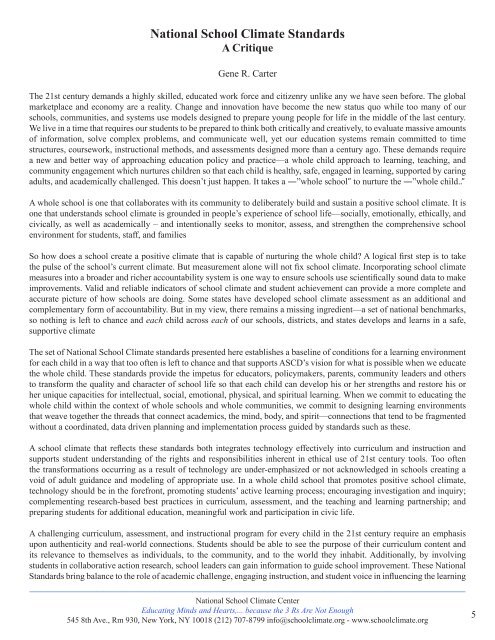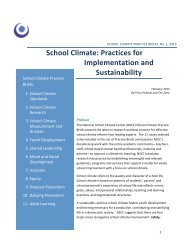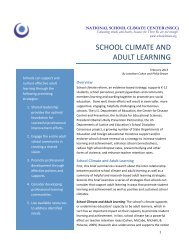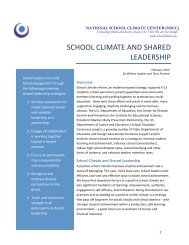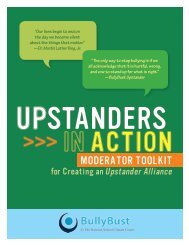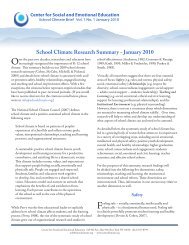Download PDF - National School Climate Center
Download PDF - National School Climate Center
Download PDF - National School Climate Center
You also want an ePaper? Increase the reach of your titles
YUMPU automatically turns print PDFs into web optimized ePapers that Google loves.
<strong>National</strong> <strong>School</strong> <strong>Climate</strong> Standards<br />
A Critique<br />
Gene R. Carter<br />
The 21st century demands a highly skilled, educated work force and citizenry unlike any we have seen before. The global<br />
marketplace and economy are a reality. Change and innovation have become the new status quo while too many of our<br />
schools, communities, and systems use models designed to prepare young people for life in the middle of the last century.<br />
We live in a time that requires our students to be prepared to think both critically and creatively, to evaluate massive amounts<br />
of information, solve complex problems, and communicate well, yet our education systems remain committed to time<br />
structures, coursework, instructional methods, and assessments designed more than a century ago. These demands require<br />
a new and better way of approaching education policy and practice—a whole child approach to learning, teaching, and<br />
community engagement which nurtures children so that each child is healthy, safe, engaged in learning, supported by caring<br />
adults, and academically challenged. This doesn’t just happen. It takes a ―”whole school” to nurture the ―”whole child..”<br />
A whole school is one that collaborates with its community to deliberately build and sustain a positive school climate. It is<br />
one that understands school climate is grounded in people’s experience of school life—socially, emotionally, ethically, and<br />
civically, as well as academically – and intentionally seeks to monitor, assess, and strengthen the comprehensive school<br />
environment for students, staff, and families<br />
So how does a school create a positive climate that is capable of nurturing the whole child? A logical first step is to take<br />
the pulse of the school’s current climate. But measurement alone will not fix school climate. Incorporating school climate<br />
measures into a broader and richer accountability system is one way to ensure schools use scientifically sound data to make<br />
improvements. Valid and reliable indicators of school climate and student achievement can provide a more complete and<br />
accurate picture of how schools are doing. Some states have developed school climate assessment as an additional and<br />
complementary form of accountability. But in my view, there remains a missing ingredient—a set of national benchmarks,<br />
so nothing is left to chance and each child across each of our schools, districts, and states develops and learns in a safe,<br />
supportive climate<br />
The set of <strong>National</strong> <strong>School</strong> <strong>Climate</strong> standards presented here establishes a baseline of conditions for a learning environment<br />
for each child in a way that too often is left to chance and that supports ASCD’s vision for what is possible when we educate<br />
the whole child. These standards provide the impetus for educators, policymakers, parents, community leaders and others<br />
to transform the quality and character of school life so that each child can develop his or her strengths and restore his or<br />
her unique capacities for intellectual, social, emotional, physical, and spiritual learning. When we commit to educating the<br />
whole child within the context of whole schools and whole communities, we commit to designing learning environments<br />
that weave together the threads that connect academics, the mind, body, and spirit—connections that tend to be fragmented<br />
without a coordinated, data driven planning and implementation process guided by standards such as these.<br />
A school climate that reflects these standards both integrates technology effectively into curriculum and instruction and<br />
supports student understanding of the rights and responsibilities inherent in ethical use of 21st century tools. Too often<br />
the transformations occurring as a result of technology are under-emphasized or not acknowledged in schools creating a<br />
void of adult guidance and modeling of appropriate use. In a whole child school that promotes positive school climate,<br />
technology should be in the forefront, promoting students’ active learning process; encouraging investigation and inquiry;<br />
complementing research-based best practices in curriculum, assessment, and the teaching and learning partnership; and<br />
preparing students for additional education, meaningful work and participation in civic life.<br />
A challenging curriculum, assessment, and instructional program for every child in the 21st century require an emphasis<br />
upon authenticity and real-world connections. Students should be able to see the purpose of their curriculum content and<br />
its relevance to themselves as individuals, to the community, and to the world they inhabit. Additionally, by involving<br />
students in collaborative action research, school leaders can gain information to guide school improvement. These <strong>National</strong><br />
Standards bring balance to the role of academic challenge, engaging instruction, and student voice in influencing the learning<br />
_____________________________________________________________________________<br />
<strong>National</strong> <strong>School</strong> <strong>Climate</strong> <strong>Center</strong><br />
Educating Minds and Hearts,... because the 3 Rs Are Not Enough<br />
545 8th Ave., Rm 930, New York, NY 10018 (212) 707-8799 info@schoolclimate.org - www.schoolclimate.org<br />
5


